Stock Market Technicals Point to Strong Rally
Stock-Markets / US Stock Markets Nov 22, 2008 - 06:42 PM GMTBy: Mike_Burk
 The good news is: In the 1930's, the last time we saw declines of this magnitude in the same time frame, the rallies that followed took the S&P 500 (SPX) up 20% - 46%.
The good news is: In the 1930's, the last time we saw declines of this magnitude in the same time frame, the rallies that followed took the S&P 500 (SPX) up 20% - 46%.
Short Term As of Thursday's close the SPX was down over 40% in less than 3 months, a rare occurrence. From its August 87 high to its October crash low the SPX was down 33.2%. Late 1937 was the last time the SPX fell more than 40% in 3 months, 71 years ago.
The charts below show every example of the SPX falling more than 40% in 3 months or less since 1928. Dashed vertical lines have been drawn on the 1st trading day of each month. The 1st chart shows the current period as of last Friday, all of the others include a month or so after the bottom so you can see the nature of the rally that followed the low.
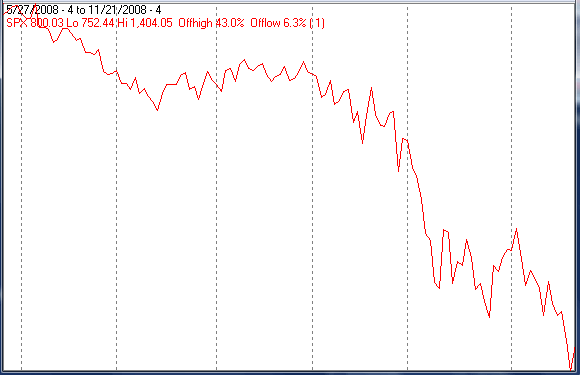
The 1937 low occurred in late November, the pattern and time frame are similar to what we have recently experienced.
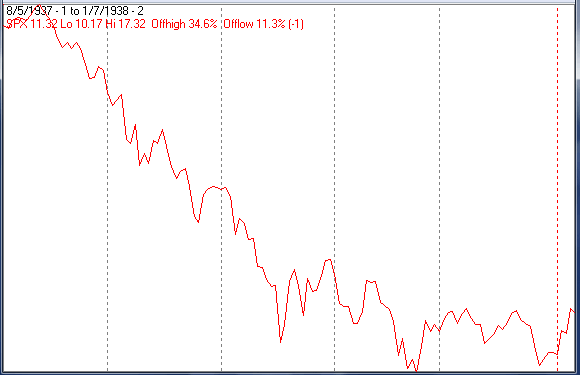
The next chart shows the bear market low of June 1, 1932, the SPX was 86.2% off its 1929 high.

The SPX hit a low in early October 1931 then rallied 30.6% in a little over a month. The chart ends at the rally high.
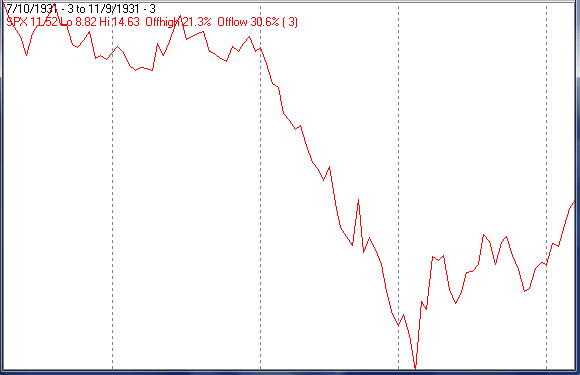
The SPX hit its crash low in November 1929 then rallied 46% in the next 5 months.
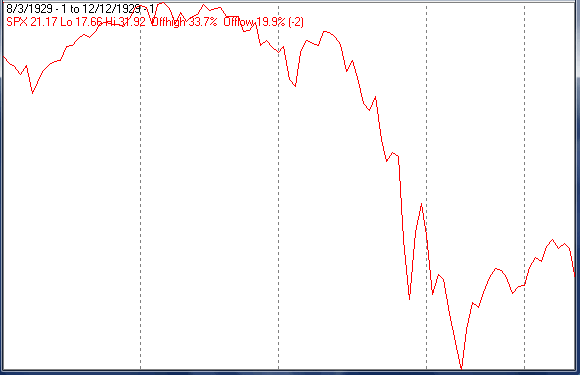
I found no examples of the SPX falling more than 50% in 3 months so there is hope for a rally.
Intermediate term
There were 1514 new lows on the NASDAQ October 10.
There were 788 new lows on the NASDAQ on October 24.
There were 664 new lows on the NASDAQ on November 13.
There were 1158 new lows on the NASDAQ on November 20.
I do not have a magic number for new lows that would mark the bottom on a retest, but, anything over 400 makes me uncomfortable. 1158 new lows on the NASDAQ last Thursday suggest the bear market lows have yet to be seen.
The chart below covers the past year and a half showing the NASDQ composite (OTC) in blue and a 10% trend (19 day EMA) of NASDAQ new lows (OTC NL) in black. OTC NL has been plotted on an inverted Y axis so decreasing new lows move the indicator upward (up is good).
The indicator turned sharply downward last week, but is still above its October lows.
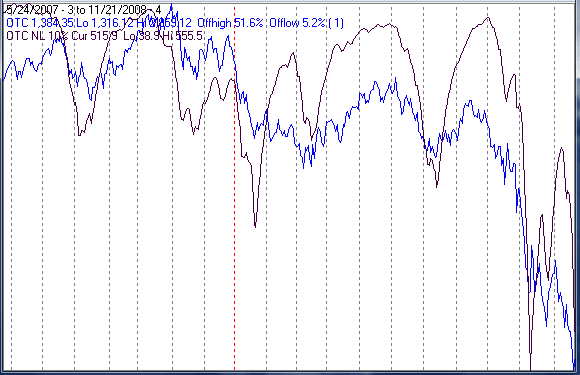
New highs and new lows began being calculated in their present form in 1978 so their usefulness is limited to the last 30 years.
Our most recent bear market 2000 - 2002 is shown in the chart below.
The chart covers 3 years and the index and indicator are the same as in the chart above.
There were 434 new lows on the NASDAQ at the October 9, 2002 low. The highest number of NASDAQ new lows during the 2000 - 2002 bear market was 788 on December 21, 2000 (same as October 24 this year).
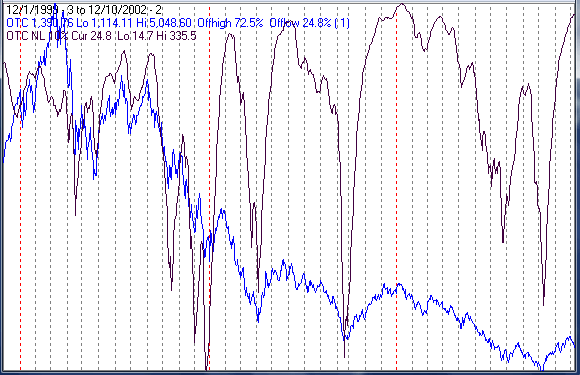
Seasonality
Next week is the week of Thanksgiving during the 4th year of the Presidential Cycle.
The tables show the daily return on a percentage basis for week of Thanksgiving during the 4th year of the Presidential Cycle. OTC data covers the period from 1963 - 2007 and SPX data from 1953 - 2007. There are summaries for both the 4th year of the Presidential Cycle and all years combined. Prior to 1953 the market traded 6 days a week so that data has been ignored.
The averages, over all periods, have been pretty strong and the 4th year of the Presidential Cycle has been stronger than the average of all years.
Report for 3 days before Thanksgiving and 1 day after. Day1 = the day after
The number following the year represents its position in the presidential cycle.
The number following the daily return represents the day of the week;
1 = Monday, 2 = Tuesday etc.
| OTC Presidential Year 4 | |||||
| Day4 | Day3 | Day2 | Day1 | Totals | |
| 1964-4 | -0.16% 1 | -0.40% 2 | -0.18% 3 | -0.16% 5 | -0.90% |
| 1968-4 | 0.47% 1 | 0.20% 2 | 1.52% 3 | 0.68% 5 | 2.86% |
| 1972-4 | -0.16% 1 | 0.05% 2 | 0.23% 3 | 0.40% 5 | 0.52% |
| 1976-4 | 0.56% 1 | -0.28% 2 | 0.52% 3 | 0.80% 5 | 1.61% |
| 1980-4 | -0.90% 1 | 0.58% 2 | 0.80% 3 | 0.53% 5 | 1.01% |
| 1984-4 | -0.91% 1 | 0.07% 2 | -0.01% 3 | 1.00% 5 | 0.14% |
| Avg | -0.19% | 0.12% | 0.61% | 0.68% | 1.23% |
| 1988-4 | -0.68% 1 | 0.08% 2 | 0.66% 3 | -0.38% 5 | -0.32% |
| 1992-4 | -0.59% 1 | 1.11% 2 | 0.37% 3 | 0.18% 5 | 1.08% |
| 1996-4 | 0.47% 1 | 0.06% 2 | 0.48% 3 | 0.41% 5 | 1.42% |
| 2000-4 | -5.01% 1 | -0.14% 2 | -4.05% 3 | 5.41% 5 | -3.79% |
| 2004-4 | 0.70% 1 | -0.04% 2 | 0.88% 3 | -0.03% 5 | 1.51% |
| Avg | -1.02% | 0.21% | -0.33% | 1.12% | -0.02% |
| OTC summary for Presidential Year 4 1964 - 2004 | |||||
| Averages | -0.56% | 0.12% | 0.11% | 0.80% | 0.47% |
| %Winners | 36% | 64% | 73% | 73% | 73% |
| MDD 11/22/2000 8.98% -- 11/19/1984 .91% -- 11/24/1980 .90% | |||||
| OTC summary for all years 1963 - 2007 | |||||
| Averages | -0.26% | -0.18% | 0.28% | 0.55% | 0.40% |
| % Winners | 44% | 55% | 76% | 84% | 64% |
| SPX Presidential Year 4 | |||||
| Day4 | Day3 | Day2 | Day1 | Totals | |
| 1952-4 | 0.59% 1 | -0.24% 2 | 0.63% 3 | 0.55% 5 | 1.54% |
| 1956-4 | -0.98% 1 | -0.88% 2 | -0.49% 3 | 1.05% 5 | -1.30% |
| 1960-4 | 0.20% 1 | -0.38% 2 | 0.14% 3 | 0.59% 5 | 0.56% |
| 1964-4 | -0.32% 1 | -0.31% 2 | -0.34% 3 | -0.33% 5 | -1.30% |
| 1968-4 | 0.17% 1 | 0.73% 2 | 0.47% 3 | 0.57% 5 | 1.93% |
| 1972-4 | 0.03% 1 | 0.59% 2 | 0.59% 3 | 0.32% 5 | 1.53% |
| 1976-4 | 0.66% 1 | -0.61% 2 | 0.44% 3 | 0.72% 5 | 1.21% |
| 1980-4 | -0.58% 1 | 0.74% 2 | 0.60% 3 | 0.25% 5 | 1.01% |
| 1984-4 | -0.61% 1 | 0.66% 2 | 0.21% 3 | 1.46% 5 | 1.72% |
| Avg | -0.06% | 0.42% | 0.46% | 0.66% | 1.48% |
| 1988-4 | -0.09% 1 | 0.37% 2 | 0.67% 3 | -0.66% 5 | 0.29% |
| 1992-4 | -0.36% 1 | 0.58% 2 | 0.37% 3 | 0.23% 5 | 0.82% |
| 1996-4 | 1.11% 1 | -0.14% 2 | -0.12% 3 | 0.27% 5 | 1.11% |
| 2000-4 | -1.84% 1 | 0.35% 2 | -1.85% 3 | 1.47% 5 | -1.87% |
| 2004-4 | 0.59% 1 | -0.03% 2 | 0.41% 3 | 0.08% 5 | 1.05% |
| Avg | -0.12% | 0.23% | -0.11% | 0.28% | 0.28% |
| SPX summary for Presidential Year 4 1952 - 2004 | |||||
| Averages | -0.10% | 0.10% | 0.12% | 0.47% | 0.59% |
| %Winners | 50% | 50% | 71% | 86% | 79% |
| MDD 11/22/2000 3.32% -- 11/21/1956 2.34% -- 11/27/1964 1.30% | |||||
| SPX summary for all years 1952 - 2007 | |||||
| Averages | -0.26% | 0.12% | 0.32% | 0.42% | 0.60% |
| % Winners | 43% | 61% | 79% | 79% | 68% |
Conclusion
Last week we saw an oversold extreme not seen in 70 years. There has to be a bounce somewhere.
I expect the major indices to be higher on Friday November 28 than they were on Friday November 21.
Last weeks positive forecast was a miss.
Thank you,
By Mike Burk
To subscribe to this report : http://alphaim.net/signup.html
Gordon Harms produces a Power Point for our local timing group. You can get a copy of that at: http://www.stockmarket-ta.com/ .
Disclaimer: Mike Burk is an employee and principal of Alpha Investment Management (Alpha) a registered investment advisor. Charts and figures presented herein are believed to be reliable but we cannot attest to their accuracy. Recent (last 10-15 yrs.) data has been supplied by CSI (csidata.com), FastTrack (fasttrack.net), Quotes Plus (qp2.com) and the Wall Street Journal (wsj.com). Historical data is from Barron's and ISI price books. The views expressed are provided for information purposes only and should not be construed in any way as investment advice. Furthermore, the opinions expressed may change without notice.
Mike Burk Archive |
© 2005-2022 http://www.MarketOracle.co.uk - The Market Oracle is a FREE Daily Financial Markets Analysis & Forecasting online publication.



